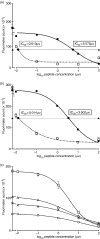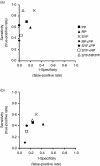HLA Class II molecules on haplotypes associated with type 1 diabetes exhibit similar patterns of binding affinities for coxsackievirus P2C peptides
- PMID: 16236123
- PMCID: PMC1802420
- DOI: 10.1111/j.1365-2567.2005.02233.x
HLA Class II molecules on haplotypes associated with type 1 diabetes exhibit similar patterns of binding affinities for coxsackievirus P2C peptides
Abstract
Enteroviruses such as coxsackievirus B4 (CVB4) are proposed as possible environmental triggers or accelerants of the autoimmune process that leads to type 1 diabetes mellitus. One putative mechanism to account for this association is mimicry between virus components and islet autoantigens. Particular interest has focused on the CVB4 non-structural protein P2C, which we previously showed to be a major target of the effector memory anti-CVB4 CD4 T-cell response, and which harbours a region of sequence similarity with the islet autoantigen, glutamic acid decarboxylase (GAD65). Since several distinct human leucocyte antigen (HLA) Class II molecules are associated with development of type 1 diabetes, we hypothesized that for functional mimicry to be important, any potential region(s) of mimicry in P2C should bind to each of these susceptibility molecules. In the present study therefore we examined the affinity of 20-mer overlapping P2C peptides for soluble HLA-DR4, -DR3, -DQ2 and -DQ8. We identified one discrete region of P2C with high binding affinities for all of these HLA Class II molecules. Moreover, the binding affinity of P2C peptides was significantly correlated between HLA molecules present on the same susceptibility haplotype (e.g. DR4 and DQ8, P =0.0076; DR3 and DQ2 P = 0.002). We conclude that possession of these haplotypes favours restricted presentation of viral epitopes, and speculate that this could promote the potential for mimicry between microbial proteins and islet autoantigens.
Figures




References
-
- Buzzetti R, Quattrocchi CC, Nistico L. Dissecting the genetics of type 1 diabetes: relevance for familial clustering and differences in incidence. Diabetes Metab Rev. 1998;14:111–28. - PubMed
-
- Redondo MJ, Yu L, Hawa M, Mackenzie T, Pyke DA, Eisenbarth GS, Leslie RD. Heterogeneity of type I diabetes: analysis of monozygotic twins in Great Britain and the United States. Diabetologia. 2001;44:354–62. - PubMed
-
- Olmos P, A'Hern R, Heaton DA, Millward BA, Risley D, Pyke DA, Leslie RD. The significance of the concordance rate for type 1 (insulin-dependent) diabetes in identical twins. Diabetologia. 1988;31:747–50. - PubMed
-
- Yoon JW, Austin M, Onodera T, Notkins AL. Isolation of a virus from the pancreas of a child with diabetic ketoacidosis. N Engl J Med. 1979;300:1173–9. - PubMed
-
- Clements GB, Galbraith DN, Taylor KW. Coxsackie B virus infection and onset of childhood diabetes. Lancet. 1995;346(8969):221–3. - PubMed
Publication types
MeSH terms
Substances
LinkOut - more resources
Full Text Sources
Other Literature Sources
Medical
Molecular Biology Databases
Research Materials
Miscellaneous

